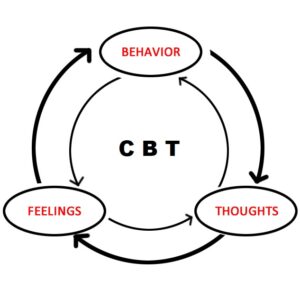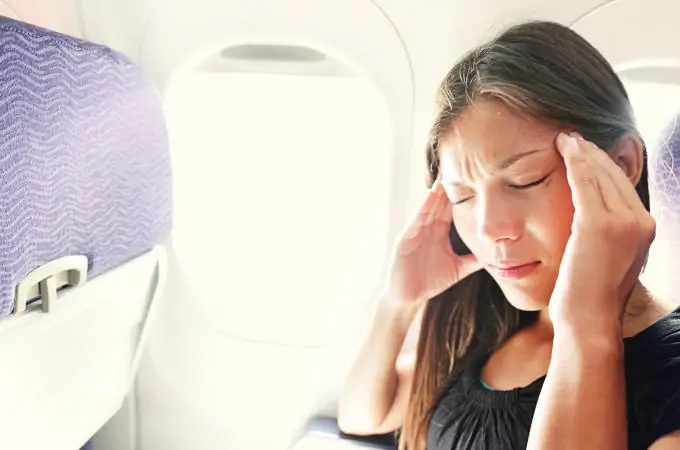Do you avoid flying because of your fear of heights? If so, you are not alone. Many people are terrified of flying, even though it is one of the safest forms of transportation. In this blog post, we will discuss how to overcome your fear of flying using cognitive behavioral therapy (CBT). We will go over each step in detail and provide helpful tips along the way. So, if you are ready to take control of your fear, keep reading!
Contents
What Is CBT?
 Cognitive behavioral therapy (CBT) is a type of psychological treatment. It has been proven to be effective in helping people deal with a wide range of mental health issues, including depression, anxiety, phobias, and addiction. CBT focuses on changing maladaptive thoughts and beliefs in order to change how a person behaves in certain situations.
Cognitive behavioral therapy (CBT) is a type of psychological treatment. It has been proven to be effective in helping people deal with a wide range of mental health issues, including depression, anxiety, phobias, and addiction. CBT focuses on changing maladaptive thoughts and beliefs in order to change how a person behaves in certain situations.
This particular form of psychotherapy looks at how thoughts, feelings, and behavior interact in order to better understand the impact of mental health issues. CBT is based on the idea that thoughts and behaviors can be changed, which then leads to positive changes in emotion and behavior. Be sure to explore the benefits of Cognitive Behavioural Therapy with your therapist. It can be used to help you overcome numerous mental health issues and improve overall health.
Can CBT Help With Fear Of Flying?
If you have fear of flying, CBT can help you to understand the fears and anxieties related to flying and create a strategy for managing them. Through CBT, you can learn about cognitive distortions that may be leading to your fear. And replace them with more balanced thoughts. Additionally, CBT can provide helpful tools for managing anxiety in other areas of life. Such as relaxation techniques and mindfulness.
CBT is also useful for helping you face your fear in manageable steps. A CBT therapist will work with you to identify the cognitive errors that lead to fear. And then create a plan to help you gradually face the fear. By setting realistic goals and expectations, you can slowly work up to facing your fear of flying while in a safe environment.
Overall, CBT for fear of flying can help you to understand the root of your fear, create manageable goals for overcoming it, and develop effective strategies for managing anxiety. With the guidance of a trained CBT therapist, you can learn to better manage your fear.
What Techniques Does CBT Involve For Fear Of Flying?
Each person’s fear of flying is unique and requires a tailored approach. However, some common techniques used in CBT for fear of flying include:
Psychoeducation
This involves learning about the physiology and psychology of fear and how it affects the body. It can help people to understand their reactions, better cope with anxiety or panic, and know when to seek help. For example, you may learn about the fight or flight response and how it can be managed. This will more likely give you a better understanding of how to manage your fear.
Cognitive restructuring
This helps people challenge their unhelpful thoughts and beliefs about flying and replace them with more realistic, helpful ones. It can help people become less anxious in the face of uncertainty and gain a sense of control. This technique is often used in combination with exposure therapy. As people gradually confront their fear and learn how to manage it.
Exposure practice
This involves gradually facing fear by imagining a flight or stepping on an aircraft. This can be done through guided imagery, role-playing, virtual reality, and other techniques. Exposure practice helps to reduce anxiety and fear. As well as increase confidence in the face of flying. It might also help to have a friend or therapist accompany you on the first few flights. So that they can provide support and guidance.
Relaxation techniques
 These involve learning how to relax your body and mind. This could include deep breathing, progressive muscle relaxation, and other techniques. Relaxation techniques can be done before, during, and after a flight to help manage anxiety and fear. You can start by practicing these techniques at home and then gradually doing them on the plane.
These involve learning how to relax your body and mind. This could include deep breathing, progressive muscle relaxation, and other techniques. Relaxation techniques can be done before, during, and after a flight to help manage anxiety and fear. You can start by practicing these techniques at home and then gradually doing them on the plane.
Self-monitoring
This helps people become more aware of their thoughts and behaviors related to flying. Self-monitoring can be done by keeping track of the frequency and intensity of anxious thoughts, as well as how often you are engaging in safety behaviors like avoiding flights or carrying a safety item on the plane. This can help to identify triggers and learn how to better manage fear.
Mindful meditation
Finally, this technique helps people become more aware of the present moment and their thoughts, emotions, and body sensations. It can help to reduce worrying and ruminating about future flights, as well as manage anxiety in the present.
With the right approach, CBT for fear of flying can help people feel more confident about air travel. You just need to find the techniques that work best for you and practice them regularly. With consistent effort, your fear of flying can be managed and eventually eliminated.
How Many Sessions In CBT For Fear Of Flying?
The exact number of sessions required in CBT for fear of flying will depend on the individual’s needs and goals. Generally, six to eight sessions are recommended, but some individuals may need fewer or more sessions to gain the desired results. Each session typically lasts for about an hour and includes:
- discussions about fears associated with flying
- problem-solving skills
- relaxation techniques
- gradual exposure to flying experiences
During each session, the therapist will discuss any progress made and help the individual develop coping strategies to manage their fear. At the end of treatment, the individual should have developed a better understanding of their fear and be equipped with skills to help them fly confidently.
Depending on the individual’s progress and needs, follow-up sessions may also be recommended to continue working through any underlying issues contributing to the fear of flying. It is important that individuals work through the process of CBT for fear of flying with a skilled therapist to get the most benefit from it.
What Are The Potential Benefits?
 CBT for fear of flying can provide a number of benefits to the individual seeking treatment. These benefits include:
CBT for fear of flying can provide a number of benefits to the individual seeking treatment. These benefits include:
1. Increased feelings of control and mastery: CBT can help individuals to gain an understanding of their fear, how it works, and how to manage it in a more effective way. Through various techniques, things like relaxation and visualization can help the individual to learn how to better control their fear response.
2. Improved coping skills: During CBT, individuals will be taught various coping techniques for dealing with anxious thoughts or feelings associated with flying. Coping skills such as mindfulness, distraction, and deep breathing can all help a person manage their fear in an appropriate way.
3. Increased self-confidence: As individuals confront their fear of flying and gain a better understanding of it, they can feel more confident in themselves. This increased confidence can help them to combat future fears that arise and create a more positive outlook on life overall.
4. Improved relationships: Fear of flying can be isolating, as the individual avoids situations that involve flying or traveling. Through CBT, individuals can learn to manage their fear and gain the confidence to reconnect with family and friends who are important to them.
5. Improved quality of life: Being able to conquer your fear of flying can help lead to an improved overall quality of life. Without the fear, individuals can experience more freedom and flexibility in terms of their travel plans and have greater opportunities to explore the world. In addition, being able to fly without fear can reduce stress levels and help a person feel healthier overall.
Overall, CBT for fear of flying can be an effective treatment that helps individuals to manage their fear in a safe and effective way. It can provide individuals with the tools they need to confront their fear and gain back control over their life. With the right guidance and support, anyone can learn how to conquer their fear of flying and get back in the air.
How Long Does CBT Take To Recovery?
Fear of flying is a common concern among many people. Although CBT has been shown to be an effective treatment for this issue, the length of time it takes to recover can vary greatly depending on the individual and their specific needs. For example, individuals who have had a traumatic experience related to flying may need more intensive therapy or longer sessions.
And on the other end of the spectrum, individuals who are just feeling anxious about flying may not need as intense treatment. Or as many sessions. Typically, most people require at least 8-12 CBT sessions. But this can vary depending on their particular needs.
In addition to the number of sessions needed, the length and frequency of each session are also important to consider. Generally, CBT sessions will last for 50-60 minutes. And occur weekly or biweekly depending on the individual’s schedule and availability.
Conclusion
In a nutshell, CBT for fear of flying may be an effective treatment option for those who suffer from severe anxiety or fear of the air. It can help to reduce levels of stress. And provide individuals with the tools they need to manage their emotions better when faced with uncomfortable situations. By using cognitive restructuring, relaxation techniques, exposure therapy, and other CBT methods, sufferers can learn to manage their fear.
For more information, please contact MantraCare. A phobia is a serious behavior that can cause physical, emotional, or psychological harm to a person. If you have any queries regarding Online Counseling experienced therapists at MantraCare can help: Book a trial Online therapy session


